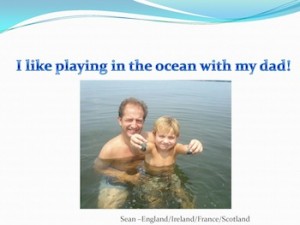Learning About Ourselves and Others in Pre-Kindergarten and Kindergarten
Christie Furnari, Elizabeth Soper, and Darlene Wolinski
As teachers of very young children, we know how important it is for our children to distinguish and celebrate how they, their families, and their lives are similar to and different from others. In this vignette we each share how our children grew in their understandings of themselves and others through our readings, discussions and experiences with global literature in our classrooms. For an overview of our literacy community and school community, please see the first vignette in this issue, “Learning about Ourselves and Others through Global Literature.”
A New Focus: Understanding Ourselves through Global Picturebooks: Christie Furnari
In fall 2011, I joined a literacy community comprised of four first grade teachers, two kindergarten teachers, an art teacher, Prisca, and Ray. I teach pre-kindergarten in two half-day sessions of about 20 children. Our literacy community focused on using global children’s literature to help young children respect or “be kind” to others and appreciate themselves and each other. As the months progressed I decided to build on the theme of kindness and broaden it to include being responsible for yourself and your actions and helping each other.
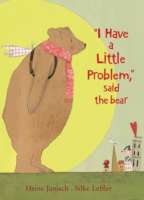 We read and discussed a range of books including I Like Me (Carlson, 1988), Whoever You Are (Fox, 1997), Spoon (Rosenthal, 2009), I Have a Little Problem (Janisch, 2007), and Spaghetti on a Hot Dog Bun (Dismondy, 2008). In these books we focused on how to have fun with ourselves, how to take care of ourselves, how wonderful we are, what to do if we fall down, what to do if we make a mistake, and what to do if we are sad. Sometimes the children drew a picture to go with the story and often I interviewed them.
We read and discussed a range of books including I Like Me (Carlson, 1988), Whoever You Are (Fox, 1997), Spoon (Rosenthal, 2009), I Have a Little Problem (Janisch, 2007), and Spaghetti on a Hot Dog Bun (Dismondy, 2008). In these books we focused on how to have fun with ourselves, how to take care of ourselves, how wonderful we are, what to do if we fall down, what to do if we make a mistake, and what to do if we are sad. Sometimes the children drew a picture to go with the story and often I interviewed them.
One book that was particularly meaningful was Marvelous Me (Bullard, 2003), the story of young Alex who is like other children in some ways (i.e., imaginative, feeling sad or happy) but in other ways is very unique and special (i.e., his smile, his hug). After reading and talking about this book I asked the children to draw a picture showing what was marvelous about each of them. Then I interviewed each child, asking about their picture, what they did if they had a problem and what they did if they got sad. The questions were to help them think about being responsible for themselves. I also asked them to complete the sentence, “You are …”, telling me what I should say about them.
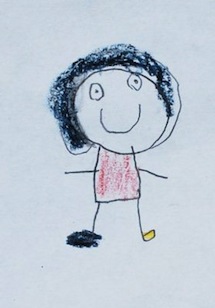 |
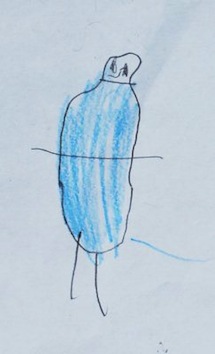 |
| Figure 1. Carmelita’s picture showing why she is marvelous. |
Figure 2. Talon’s picture showing why he is marvelous. |
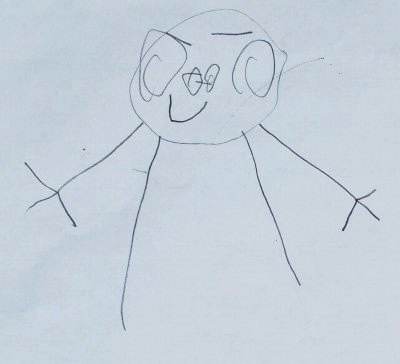 |
|
Figure 3. Leila’s picture showing why she is marvelous. |
The children’s pictures and responses to my questions allowed me to see the range of ways my students thought they were marvelous. For example, Carmelita, a second language learner, said “I like play my bicycle in my house. I like to play with my jump rope in my house. I like to eat too much fruit.” If she has a problem, she said she “pick myself up” and if she is sad she “stop and think.” She told me that what I should say about her was “You are important.” Talon, a high energy friend I had to interview on the move, said he was marvelous because “games…I like playing with my friends. I like playing with my family. I love my mother, my father, my sister, and my grandmother and everybody in the world.” If he has a problem, “pick yourself up and give another chance.” If he gets sad “somebody always cheer me up.” Leila said that if she gets sad, “Pick myself up and get my smile back.”
It was a rich year that brought on a deeper understanding of ourselves, others, and literature. Students were aware of how to be kind and could communicate how they felt and thought. Next year I will use these same ideas but include more speaking and listening experiences in small group meetings. I am excited to use literature from last year and add new books focusing on self-awareness. After last year I can tie the concept of same and different even further into science to focus on a respect for living things and our world.
Celebrating Our Families: Elizabeth Soper
Throughout the year my kindergarten children and I read global picturebooks that helped us think about the lives of children and families in other cultures around the world. Even though my classroom was very diverse, the children seemed unaware of the differences between them. While I was glad the children were so accepting of each other, I also wanted them to realize and appreciate their differences. I wanted them to recognize and celebrate how unique, beautiful, and special they each are and value and respect that specialness in each other.
We read many fiction and non-fiction global picturebooks over the year that helped the children understand that there are other cultures in the world beyond their reality. These included
 Waiting for the Biblioburro (Brown, 2011), For You Are a Kenyan Child (Cunnane, 2006), and Our Grandparents: A Global Album (Ajmera, Kinkade, Pon, & Tutu, 2010). The last book we read was also one of the first: You and Me Together: Moms, Dads, and Kids around the World (Kerley, 2010). This nonfiction book displays color photos with brief phrases describing parents and children in places around the world involved in such everyday activities as work, play, prayer, conversation, or travel. I read the book on the document camera so the children could see the photos. As we read, the children commented on the clothing the families wore, their work, and the range of activities they were engaged in, such cooking, dancing, talking, and taking a walk. They could see that children around the world were like them in similar yet different ways. When we finished the book, Charlotte suggested, “Why don’t we make a book like that about us?” How could I resist that?
Waiting for the Biblioburro (Brown, 2011), For You Are a Kenyan Child (Cunnane, 2006), and Our Grandparents: A Global Album (Ajmera, Kinkade, Pon, & Tutu, 2010). The last book we read was also one of the first: You and Me Together: Moms, Dads, and Kids around the World (Kerley, 2010). This nonfiction book displays color photos with brief phrases describing parents and children in places around the world involved in such everyday activities as work, play, prayer, conversation, or travel. I read the book on the document camera so the children could see the photos. As we read, the children commented on the clothing the families wore, their work, and the range of activities they were engaged in, such cooking, dancing, talking, and taking a walk. They could see that children around the world were like them in similar yet different ways. When we finished the book, Charlotte suggested, “Why don’t we make a book like that about us?” How could I resist that?
I read the story again, this time asking the children to think about something that they do with a family member. When we finished reading, I invited the children to illustrate their thoughts on paper. To further build on Charlotte’s idea, I emailed the parents and asked them to send a photo of their child and a family member (that they did not need returned) engaged in an activity so we could create our own photo book. We had been studying text features in nonfiction books, specifically related to photographs, and I knew our book would be a wonderful connection to those discussions for the children. As the photos came in, I put them into our “book” (which was a PowerPoint presentation). Since time was short (we were literally in the last few days of school), I interviewed each child about their photo and added their words to their slide. For the few children who did not bring a photograph, I took a photo of them engaged in activity they chose to do in the classroom.
Figure 4. Class book (pdf download).
Our book was amazing and highlighted the uniqueness of each child and family. We read it many times in those closing days and the children were very proud of their book. It was a powerful way to end year and celebrate the richness of the diversity in the children and their families.
Crossing Cultural Borders through Global Picturebooks: Darlene Wolinski
During this past year the teachers in our literacy community focused on helping our students understand who they are as cultural beings. We started by connecting a photo of each student to their country of origin on a world map so they could conceptualize their cultural heritage. I had students with family origins in places like Poland, Greece, Cyprus, Pakistan, El Salvador, and Africa.
We read a range of global picturebooks set in different countries to increase students’ awareness of themselves and others throughout the world. Whenever we read a book associated with a place where any student had family origins, we talked about and celebrated that cultural heritage.
Each story we read shared children’s lives and experiences that crossed cultural borders and made students aware of similarities among people despite differences in backgrounds, families, and where and how they live. For each story, students drew and wrote a response that connected to the story and/or an art concept shown in the illustrations. For example, in Dear Juno (Pak, 1999) Juno’s parents are too busy to read him a letter he receives from his Korean grandmother. Juno opens the letter himself and, even though he cannot read Korean, he gleans information from a dried red and yellow flower and a photograph of his grandmother and a cat that were enclosed. Juno corresponds with his grandmother through his drawings. My students wrote letters and drew pictures to send a relative as a response, experiencing the importance of communication and family. In Unique Monique (Rousaki, 2003), when Monique feels constrained by her Greek school uniform, she finds creative ways to maintain her individuality. This generated a class book in which students drew and wrote about their unique traits.
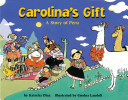 Of all the stories we read, Carolina’s Gift (Diaz, 2002), set in Peru, made the biggest impression. Carolina, in search of the perfect gift for her Abuelita, picks a walking stick with a carved hummingbird from the Sunday market. The illustrations of village life in the Andes Mountains encompassed the entire society though pictures. We saw clothing, vendors, plants, musicians, buildings, crafts, and customs different from our own. We also talked about the beautiful patterns in the clothes and other artifacts that were representative of that culture. As Carolina traveled through the market, the class traveled with her and understood much of what composed their material culture. The students could then apply this knowledge to their own lives, making their global awareness relevant to them personally.
Of all the stories we read, Carolina’s Gift (Diaz, 2002), set in Peru, made the biggest impression. Carolina, in search of the perfect gift for her Abuelita, picks a walking stick with a carved hummingbird from the Sunday market. The illustrations of village life in the Andes Mountains encompassed the entire society though pictures. We saw clothing, vendors, plants, musicians, buildings, crafts, and customs different from our own. We also talked about the beautiful patterns in the clothes and other artifacts that were representative of that culture. As Carolina traveled through the market, the class traveled with her and understood much of what composed their material culture. The students could then apply this knowledge to their own lives, making their global awareness relevant to them personally.
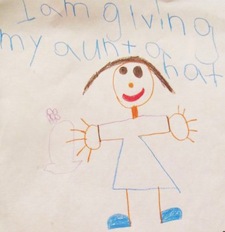 |
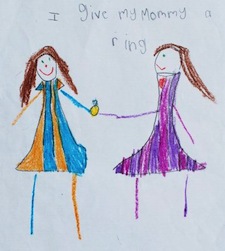 |
| Figure 5. Picture showing what Alisa would like to give her aunt. | Figure 6. Picture showing what Monica would like to give her mother. |
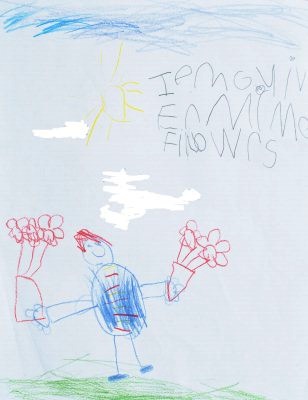 |
|
Figure 7. Picture showing what Jacob would like to give his mother. |
In response to Carolina’s Gift, the children drew and wrote about what they would like to give their family members. They talked about giving such things as flowers, Girl Scout cookies, a game, and a bull dog to their mothers, brothers, sisters, and fathers. In her drawing, Alisa chose to give her aunt a hat with a flower, connecting to the part of the story that mentioned that in Peruvian culture hats are worn by unmarried women. Alisa so well grasped an understanding of the custom that she made a connection to her own family. Monica drew herself with her mother and wrote, “I give my mommy a ring.” Jacob drew himself carrying flowers and wrote, “I’m giving my mom flowers.” Both Monica and Jacob included patterns on the clothing in their pictures, picking up on the patterns they saw in the story.
Through the books we read, students’ global understanding increased. They found that they have much in common with the characters regardless of the geography, ethnicity, or background. Those differences allowed them to appreciate other cultures and grow in compassion.
References
Ajmera, M., Derstine, E., & Pon, C. (2012). What we wear: Dressing up around the world. Watertown, MA: Charlesbridge.
Ajmera, M., Kinkade, S., Pon, C., & Tutu, D. (2010). Our grandparents: A global album. Watertown, MA: Charlesbridge.
Brown, M. (2011). Waiting for the biblioburro. Illus. by J. Parra. New York: Tricycle.
Bullard, L. (2003). Marvelous me. Illus. by B. Reibeling. Mankato, MN: Picture Window.
Carlson, N. (1988). I like me! New York: Penguin.
Chessen, B., & Berger, S. (1999). Hello. New York: Scholastic.
Cunnane, K. (2006). For you are a Kenyan child. Illus. by A. Juan. New York: Atheneum.
Diaz, K. (2002). Carolina’s gift: A story of Peru. Illus. by G. Landolt. Norwalk, CT: Soundprints.
Dismondy, M. (2008). Spaghetti on a hot dog bun: Having the courage to be who you are. Illus. by K. Shaw-Peterson. Northville, MI: Ferne Press (Making Spirits Bright)
Easterling, L. (2007). Families. Chicago, IL: Heinemann Library.
Fox, M. (1997). Whoever you are. Illus. by L. Staub. New York: Harcourt Brace.
Janisch, H. (2007). “I have a little problem,” said the bear. Illus. by S. Leffler. New York: NorthSouth.
Kerley, B. (2010). You and me together: Moms, dads, and kids around the world. Washington, D.C.: National Geographic Children’s Books.
Pak, S. (1999). Dear Juno. Illus. by S. K. Hartung. New York: Viking.
Rosenthal, A.K. (2009). Spoon. Illus. by S. Magoon. New York: Scholastic.
Rousaki, M. (2003). Unique Monique. Illus. by P. Papanikolaou. La Jolla, CA: Kane/Miller.
Christie Furnari teaches pre-kindergarten at Pot Springs Elementary School in Maryland.
Elizabeth Soper teaches kindergarten at Pot Springs Elementary School in Maryland.
Darlene Wolinski teaches kindergarten at Pot Springs Elementary School in Maryland.
WOW Stories, Volume IV, Issue 5 by Worlds of Words is licensed under a Creative Commons Attribution-NonCommercial-ShareAlike 4.0 International License.
Based on a work at <a href="https://wowlit.org/on-line-publications/stories/iv5" target="_blank".

